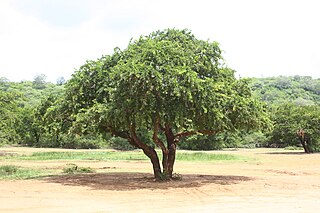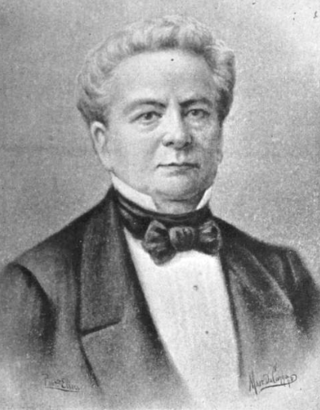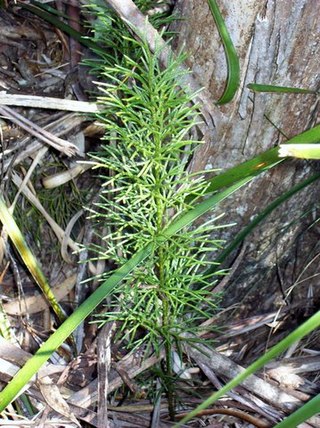
Persicaria maculosa is an annual plant in the buckwheat family, Polygonaceae. Common names include lady's thumb, spotted lady's thumb, Jesusplant, and redshank. It is widespread across Eurasia from Iceland south to Portugal and east to Japan. It is also present as an introduced and invasive species in North America, where it was first noted in the Great Lakes region in 1843 and has now spread through most of the continent.

Knightia is a small genus of the family Proteaceae endemic to New Zealand, named in honor of Thomas Andrew Knight. One extant species, K. excelsa (rewarewa) is found in New Zealand. Two further Knightia species are found in New Caledonia, although they were placed in the genus Eucarpha by Lawrie Johnson and Barbara Briggs in their influential 1975 monograph "On the Proteaceae: the evolution and classification of a southern family", a placement supported in a 2006 classification of the Proteaceae. A fossil species from upper Miocene deposits in Kaikorai has been described as Knightia oblonga. Knightia has been placed in the tribe Roupaleae of the subfamily Grevilleoideae.

Carl Johan Fredrik Skottsberg was a Swedish botanist and explorer of Antarctica.

Nyctaginaceae, the four o'clock family, is a family of around 33 genera and 290 species of flowering plants, widely distributed in tropical and subtropical regions, with a few representatives in temperate regions. The family has a distinctive fruit type called an accessory fruit or anthocarp, and many genera have extremely large pollen grains.
Soejatmia is a monotypic genus of flowering plants belonging to the family Poaceae. It just contains one species, Soejatmia ridleyi(Gamble) K.M.Wong

Myracrodruon balansae is a species of flowering tree in the cashew family, Anacardiaceae, that is native to Argentina, Brazil and Paraguay.

Limonia acidissima is the only species within the monotypic genus Limonia. Common names for the species in English include wood-apple and elephant-apple. It is sometimes also called monkey fruit.
Margyricarpus is a genus of flowering plant in the family Rosaceae, native to South America.

Astronium is a genus of flowering plants in the cashew family, Anacardiaceae. It is native to Central and South America.

Lachemilla angustata is a species of plant in the family Rosaceae. It is endemic to Ecuador. As of February 2023, the genus Lachemilla was included in Alchemilla by Plants of the World Online, with Lachemilla angustata treated as "unplaced". Alchemilla angustataS.E.Fröhner is a different species, native to the Pyrenees.
Dictamnus is a genus of flowering plant in the family Rutaceae, native to temperate Eurasia from Spain to China. The genus was first described by Carl Linnaeus in 1753.

Francisco Freire Allemão e Cysneiro was a Brazilian botanist who collected in northeast Brazil and along the Rio de Janeiro. His association with the Brazilian National Museum in Rio de Janeiro took place at a time when Brazilian botany was dominated by foreigners.
The Plant List was a list of botanical names of species of plants created by the Royal Botanic Gardens, Kew and the Missouri Botanical Garden and launched in 2010. It was intended to be a comprehensive record of all known names of plant species over time, and was produced in response to Target 1 of the 2002–2010 Global Strategy for Plant Conservation, to produce "An online flora of all known plants". It has not been updated since 2013, and has been superseded by World Flora Online.

The World Checklist of Selected Plant Families was an "international collaborative programme that provides the latest peer reviewed and published opinions on the accepted scientific names and synonyms of selected plant families." Maintained by the Royal Botanic Gardens, Kew, it was available online, allowing searches for the names of families, genera and species, as well as the ability to create checklists.
Lasiorhachis is a genus of flowering plant in the family Poaceae, native to Madagascar. The taxon was first described as a subdivision of Andropogon by Eduard Hackel in 1889 and raised to a genus by Otto Stapf in 1927.

Tripidium is a genus of flowering plant in the family Poaceae, native to Spain, Morocco, Korea and New Guinea. The genus name was first published by Hildemar Wolfgang Scholz in 2006 as a replacement for the illegitimate name Ripidium.

Japanobotrychum is a genus of ferns in the family Ophioglossaceae with the sole species Japanobotrychum lanuginosum. The genus is accepted in the Pteridophyte Phylogeny Group classification of 2016, but not by some other sources.

Pseudolycopodium is a genus of lycophyte in the family Lycopodiaceae with only one species, Pseudolycopodium densum, known as the bushy clubmoss. In the Pteridophyte Phylogeny Group classification of 2016, the genus is placed in the subfamily Lycopodioideae. Some sources do not recognize the genus, sinking it into Lycopodium. Pseudolycopodium densum is native to Australia, the North Island of New Zealand and New Caledonia. It is a spore-bearing vascular plant and grows up to a metre high. It is found in a wide variety of situations, often in high rainfall areas on sandy soils.
Lopriorea is a monotypic genus of flowering plants belonging to the family Amaranthaceae. The only species is Lopriorea ruspolii.
Sohnreyia is a genus of flowering plant in the Citrus, or Rue family (Rutaceae), native to South America. They are all "palmoids" or Corner Model Trees. As such they most commonly consist of a single, pachycaul trunk topped by a rosette of very large, pinnate leaves, and are usually monocarpous. The genus was first described by Kurt Krause in 1914. The genus name of Sohnreyia is in honour of Heinrich Sohnrey (1859–1948), a German teacher and writer.













